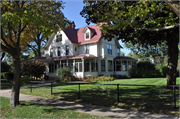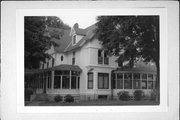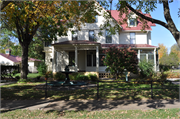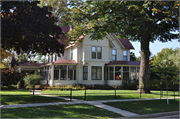Property Record
606 SUPERIOR ST
Architecture and History Inventory
| Historic Name: | William and Adelaide Irvine House |
|---|---|
| Other Name: | |
| Contributing: | Yes |
| Reference Number: | 3293 |
| Location (Address): | 606 SUPERIOR ST |
|---|---|
| County: | Chippewa |
| City: | Chippewa Falls |
| Township/Village: | |
| Unincorporated Community: | |
| Town: | |
| Range: | |
| Direction: | |
| Section: | |
| Quarter Section: | |
| Quarter/Quarter Section: |
| Year Built: | 1885 |
|---|---|
| Additions: | |
| Survey Date: | 1984 |
| Historic Use: | house |
| Architectural Style: | Queen Anne |
| Structural System: | |
| Wall Material: | Clapboard |
| Architect: | |
| Other Buildings On Site: | Y |
| Demolished?: | No |
| Demolished Date: |
| National/State Register Listing Name: | West Hill Residential Historic District |
|---|---|
| National Register Listing Date: | 10/22/2021 |
| State Register Listing Date: | 11/11/2020 |
| National Register Multiple Property Name: |
| Additional Information: | Associated record is AHI #240710 (carriage house). "Stick style" ornament in gable ends; two-story projecting front and east gabled bays; gabled roof dormer; bargeboard, dentil trim, spinal brackets and oval window ornament surfaces; porte cochere; two curved enclosed porches with diamond paned leaded glass overlights; elaborate inside chimney. Tall multiple gables overhanging upper stories, shingle and "stick style" ornament defining structural areas and the tall thin paneled ornamental chimney are the late medieval traces found in the house constructed for William Irvine in 1885, manager of the Chippewa Lumber and Boom Company from 1885 until 1911. Enclosed porches with notable leaded glass were added in the 20th century. Although altered considerably by the addition of the 20th century enclosed porches with notable leaded glass, the historically significant house built for William Irvine has been maintained as an architecturally significant representative of the Queen Anne Revival style as one of the three examples remaining in Chippewa Falls. This residence was built in 1885 for William and Adelautte (Beuidsley) Irvine and their daughter Ruth. William Irvine was a prominent lumberman and benefactor of Chippewa Falls. Arriving in Chippewa Falls in 1866, William Irvine first worked as a raftsman towing lumber for the largest sawmill at the falls, the Union Lumber Company. Irvine continued working for the Union Lumber Company until 1875, when the company was assigned to creditors. Under the new management, Irvine was promoted to sales manager. He continued with the company when it again changed hands in 1879, becoming the Chippewa Lumber and Boom Company. In 1881, lumberman magnate Fredrick Weyerhauser purchased the Chippewa Lumber and Boom Company, with Irvine becoming secretary of the new company. In 1885, Irvine was promoted to general manager of the Chippewa Lumber and Boom Company, thereby managing "the largest sawmill under one roof in the world." Irvine is credited with prolonging the life of the Chippewa Falls sawmill by at least five years through his insistence, over stockholders' opposition, of the purchase of the Manitowish tract of timber. The sawmill leased operation in 1911. William Irvine's other business activities in Chippewa Falls included acting as vice-president of the Lumberman's National Bank in Chippewa Falls, and serving on the board of directors of Wisconsin Central Railroad Company, a railroad closely associated with the development of Chippewa Falls. In 1906, Irvine secured the gift of 137 3/4 acre tract from the Chippewa Lumber and Boom Company, for the purpose of establishing a city park in Chippewa Falls. Irvine added twenty-one acres to this tract, and in 1907 purchased $5,000 worth of park bonds, which he later cancelled, and turned over to the city, thus making a cash gift for improvements to the park. A pavilion was added to the park through Irvine's efforts in 1908, and in 1912 the Chippewa Lumber and Boom Company, again through Irvine, donated an additional 100 acres. Today the park is appropriately named Irvine Park. William Irvine died in 1927. His residence was willed to his daughter Ruth Irvine Richter. In 1929, she sold the property to J. S. Truex, who owned the property until 1934. Other owners of the property are Herbert A. Culver (March-September, 1934), T.A. McDonald (1934-1958), Vincent Cinquerana (1958-1973).The property is a private residence. This property was the residence of William Irvine, an individual integrally associated with the industrial development of west central Wisconsin, and the local development, both industrial and social, of Chippewa Falls, Wisconsin. William Irvine contributed to the industrial development of west central Wisconsin through his twenty-six year management of the Chippewa Lumber and Boom Company. The most successful firm of the well-known Frederick Weyerhauser interests in northern Wisconsin. Under Irvine's management, the Chippewa Lumber and Boom Company became one of the longest continuously operating saw mills in the Chippewa Valley. On a local level, William Irvine contributed to the industrial and social health of Chippewa Falls through his many business activities and through his efforts to establish a major city park, now Irvine Park. |
|---|---|
| Bibliographic References: | (A) Register of Deeds, Chippewa County (Chippewa Falls). (B) The Herald 20 February, 1885. (C) Ruth Willut, "Irvine Park: One Man's Legacy to the City He Loved," Chippewa Herald Telegram 22 November, 1980, p. 5. (D) Chippewa County Wisconsin Past and Present: A Record of Settlement Organization, Progress and Achievement, Vol. 1 (Chicago: the S. J. Clarke Publishing Company, 1913), p. 37. (E) Park Records, Irvine Park, City of Chippewa Falls, 30 September, 1930, p. 42. (F) West Central Wisconsin, A History (Indianapolis: S. J. Clarke Publishing Company, 1933) p. 31. (G) Ralph W. Hidy, Frank Ernest Hill and Allan Nevins, Timber and Men: The Weyerhauser Story (New York: The MacMillun Company, 1963), p. 100. |
| Wisconsin Architecture and History Inventory, State Historic Preservation Office, Wisconsin Historical Society, Madison, Wisconsin |





